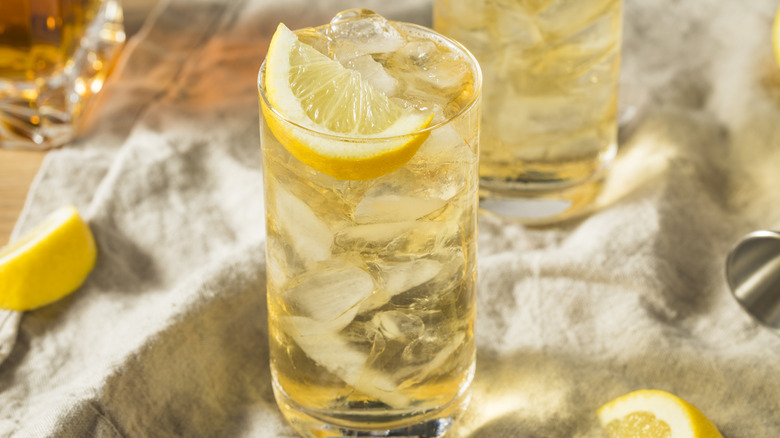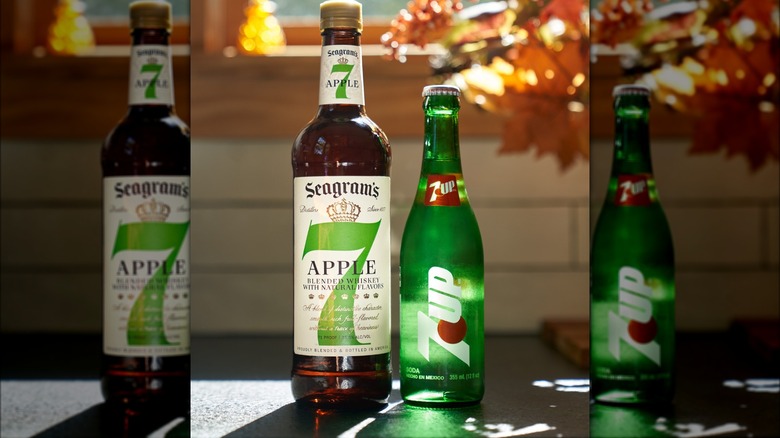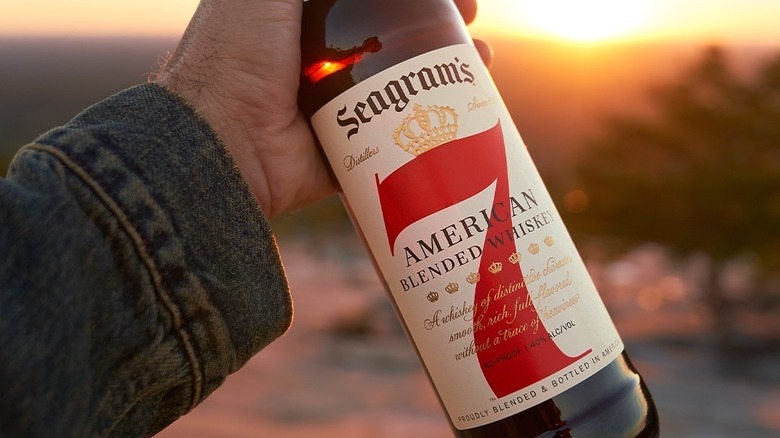What A 7 And 7 Cocktail Really Is
The 7 and 7 highball was most popular in the 1970s, but the mixed drink is still commonly ordered at bars across the U.S. and Canada.
Canada, of course, was the original home of one of the drink's two iconic ingredients: Seagram's 7 Crown blended whiskey. The drink's citrusy co-star is none other than 7UP lemon-lime soda. No, the two weren't just put together because the numbers matched, although the appropriateness of the pairing surely occurred to Seagram's when it first teamed up with the soda brand in the 1950s to launch the cross-promotional sipper.
It helped that the flavors matched, too, with the citrusy taste of 7UP complementing Seagram's 7 Crown's creamy vanilla flavor while taking the edge off the whiskey's trademark burn. It wasn't a complete surprise that the ingredients paired well together because The Seven and Seven is a variation on the old John Collins, a classic cocktail from the 19th century that's historically made with whiskey or gin, lemon juice, sugar, and soda.
It's very easy to make, a fact that's at least partly responsible for its appeal. Just pour an ounce and a half of Seagram's 7 Crown over ice in a highball glass, add four or five ounces of 7UP, stir, and if you're feeling fancy, garnish the drink with a wedge of lemon or lime.
Why the 7 and 7 became so popular in the 1970s
Fancy, of course, was never a word used to describe the 7 and 7. In its heyday, the mixed drink (a more accurate description than cocktail) was most associated with dive bars. There were several reasons for this. Seagram's price point was modest enough that even in the sketchiest of low-rent taverns, it was unlikely the management had bothered to marry the bottle with a cheaper well liquor. Additionally, its two-ingredient recipe was so easy (much like the rum and coke, or gin and tonic) that even the most inexperienced bartender could make a respectable version.
The drink itself was also cheap, meaning bar patrons weren't likely to be deterred from ordering a second round or opting for something else entirely. The quality was consistently good, too. With a typical rum and coke order, the rum isn't specified, so dive bar habitués were apt to get a cheap liquor paired with the iconic soda. The same was true with many other highballs. But with the 7 and 7, both brands were well-known, meaning drinkers knew what they were getting. That's still the case today, although Seagram's is now part of the Diageo portfolio, and is produced in the U.S. 7UP remains in operation as well, under the ownership of Keurig Dr. Pepper.
How popular is the 7 and 7 today?
Thanks to its brand recognition and the fact that its recipe has never been changed — no hip bartenders have tried to reformulate the mixed drink with small-batch syrups or bitters — the 7 and 7 has remained a bar staple. That doesn't mean it will ever again be as ubiquitous a drink order as it was during the 1970s. But it bears noting that the drink's popularity extended for more than a single decade. Seagram's 7 Crown was the top-selling liquor brand in the U.S. for more than 40 years, beginning in the late 1940s, and its signature cocktail certainly helped to drive sales during much of that run.
Seagram's, recognizing the importance of the dive bar to the drink's success, has been a promoter of these local watering holes into the 21st century. In 2018, for example, it established a holiday, National Dive Bar Day, picking the exact month and day on the calendar (7/7) one would expect for the boozy observance. The brand has also used social media to promote the dive bar lifestyle, with posts showcasing #DiveBar101 and #KeepTheDiveAlive hashtags and touting the classic 7 and 7 highball. At this point in the drink's history, classic seems like the appropriate adjective.



